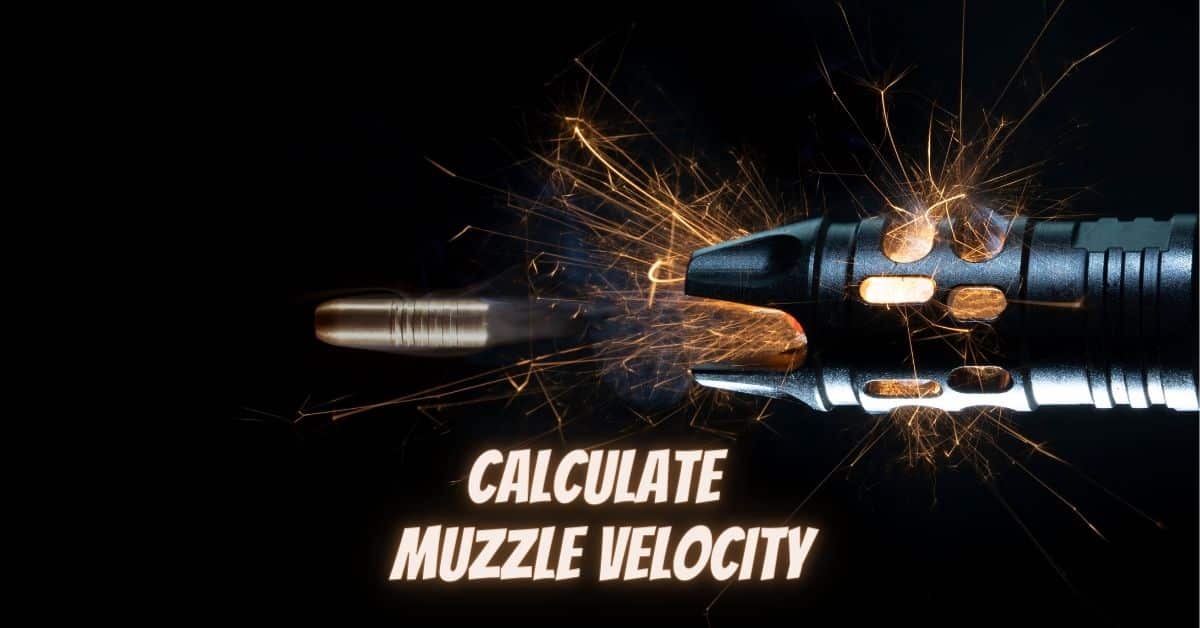Muzzle velocity plays a significant role in determining the performance and capabilities of a firearm. It signifies the initial speed at which a bullet leaves the barrel of a gun. This parameter influences various aspects of bullet behavior, including trajectory, accuracy, and penetration power. The higher the muzzle velocity, the greater the bullet’s kinetic energy and potential impact. In this article, we’ll look into what muzzle velocity is all about and introduce a handy tool, a muzzle velocity calculator, that makes figuring it out easier.
Calculate The Muzzle Velocity
Muzzle Velocity Calculator
Muzzle Velocity Calculator (Advanced)
Velocity: ft/s
The Muzzle Velocity Formula:
To calculate muzzle velocity, one can utilize a formula that relates kinetic energy (KE), bullet mass (M). The formula is as follows:
The Simplified Formula:
V = √(2 * KE / (M / 7000))
Where:
V is the muzzle velocity in feet per second (ft/s)
KE is the muzzle energy in pound-force feet (lbf-ft)
M is the mass of the bullet in grains
This formula involves squaring the kinetic energy, dividing by the adjusted mass, and taking the square root of the result. It encapsulates the intricate interplay between energy and mass to provide a clear understanding of the bullet’s initial velocity.
The Motion-Derived Formula:
V = 2 * √(P * A * d / m)
Where:
V denotes the final velocity of the projectile as it exits the barrel
P stands for the Pressure of the gas inside the barrel (in pascals)
A signifies the barrel’s cross-sectional area (in square meters).
m represents the mass of the projectile (in kilograms).
d corresponds to the distance the projectile travels down the barrel (in meters)
The practical utility of these formulas lies in capturing the essence of muzzle velocity while acknowledging varying degrees of complexity and idealized scenarios.
To simplify the process of calculating muzzle velocity, a user-friendly calculator has been developed. This tool takes the guesswork out of the equation, enabling enthusiasts, engineers, and hobbyists to swiftly and accurately determine the muzzle velocity of a given bullet.
How to Use this Muzzle Velocity Calculator:
- Enter the muzzle energy in pound-force feet (lbf – ft). If you’re unsure of the muzzle energy value, you can use a muzzle energy calculator to determine it.
- Input the mass of the bullet in grains.
- Click the “Calculate Muzzle Velocity” button.
The calculator will promptly display the calculated muzzle velocity in feet per second (ft/s), offering instant insights into the bullet’s initial velocity. This tool not only streamlines the calculation process but also empowers users to make informed decisions about ammunition selection and firearm performance.
Example Problem:
Let’s consider an example to illustrate the calculator’s effectiveness. Imagine a scenario to hunt a deer where the muzzle energy is 1000 lbf-ft and the bullet mass is 160 grain. Plugging these values into the formula, we get:
V = √(2 * 1000 / (160 / 7000))
V ≈ 295.80 ft/s
Illustrative Example (Motion-Derived Formula):
To provide a comprehensive understanding of the motion-derived formula for calculating muzzle velocity, let’s consider a practical example involving a firearm’s discharge. Imagine a scenario in which a rifle with a bullet mass of 8 grams is fired. The gas pressure within the barrel is 3000 psi, the barrel’s cross-sectional area is 0.015 square meters, and the bullet travels a distance of 0.5 meters down the barrel.
Using the motion-derived formula:
V = 2 * √(P * A * d / m)
Plugging in the provided values:
V = 2 * √(3000 psi * 0.015 m² * 0.5 m / 0.008 kg)
Converting psi to pascals: 3000 psi = 20684381.6 Pa
V = 2 * √(20684381.6 Pa * 0.015 m² * 0.5 m / 0.008 kg)
V = 2 * √(154281.11)
V ≈ 783.95 m/s
The calculator delivers this result with accuracy and efficiency, showcasing its value in practical applications.

Practical Applications of Muzzle Velocity Knowledge
Muzzle velocity holds immense importance due to its direct influence on accuracy, range, and terminal ballistics. Different applications capitalize on this knowledge in unique ways:
Military and Law Enforcement
Enhanced Accuracy
For military and law enforcement agencies, accurate shootings can be a matter of life and death. Muzzle velocity knowledge aids in calculating accurate targeting, compensating for environmental factors such as wind, and ensuring precise hits on intended targets.
Armor-Penetrating Abilities
In combat scenarios, the ability to penetrate armor can be critical. By understanding muzzle velocity, armor-piercing projectiles can be designed with the necessary speed to effectively breach protective barriers.
Hunting
Ethical Hunting
Engaging in ethical hunting is of utmost importance for responsible hunters. Ensuring a swift and humane kill not only respects the life of the animal but also contributes to the conservation of wildlife populations. One crucial aspect that aids in achieving this goal is understanding muzzle velocity, which assists hunters in selecting appropriate ammunition that delivers sufficient energy for an effective shot.
In the pursuit of ethical hunting, knowledge of the ideal shot placement is paramount. Our comprehensive guide on the best places to shoot a deer delves into this topic, providing valuable insights into the anatomy of deer and the most effective shooting locations. Feel free to explore this detailed resource for a deeper understanding of how to make ethical and responsible shots when hunting deer.
Moreover, for those seeking information on other game animals, we have dedicated guides that address shot placement for hogs and turkeys. Knowing where to shoot hogs is crucial due to their unique anatomy. Our guide on hog hunting offers essential tips and guidance for hunters aiming to make clean and efficient kills when pursuing hogs.
Similarly, understanding where to shoot a turkey is vital to ensure a swift and ethical kill during turkey hunts. Our guide on turkey hunting provides valuable information on shot placement for different scenarios, helping hunters make well-informed decisions in the field.
By accessing these detailed resources, you’ll not only enhance your hunting skills but also contribute to the ethical and responsible practices that sustain our wildlife and preserve the integrity of the hunting tradition.
Choosing the Right Firearm
Different game and hunting conditions require varying levels of muzzle velocity. Whether hunting small games at short ranges or pursuing large games at longer distances, selecting the appropriate firearm with the right muzzle velocity contributes to a successful hunt.
Sports Shooting
Target Shooting
Muzzle velocity affects target shooting accuracy. Consistent muzzle velocities contribute to tighter shot groups, enhancing the overall shooting experience and allowing shooters to refine their skills.
Competitions
In shooting competitions, where precision is paramount, participants use their knowledge of muzzle velocity to make precise adjustments to their aiming and firing techniques, giving them an edge over the competition.
Projectile Trajectory
Distance Estimation
Understanding muzzle velocity helps shooters estimate distances more accurately. By gauging how quickly a bullet drops over a given distance, shooters can adjust their aim to compensate for bullet trajectory.
Adjusting for Bullet Drop
Long-range shots require compensation for bullet drop due to gravity. Knowledge of muzzle velocity aids in calculating the necessary adjustments to hit targets at extended distances.
Ammunition Development
Optimizing Performance
Ammunition manufacturers rely on muzzle velocity data to optimize bullet performance. By fine-tuning bullet designs and powder loads, they can achieve desired ballistics, expansion, and penetration characteristics.
Balancing Recoil and Power
Muzzle velocity is a crucial factor in managing recoil. Balancing velocity with shooter comfort and firearm stability is vital for creating ammunition that is both effective and manageable.
Firearm Design
Barrel Length Considerations
Muzzle velocity is influenced by barrel length. Firearm designers consider this when creating weapons for specific purposes, such as compact handguns or long-range rifles.
Suppressor Compatibility
Muzzle velocity affects suppressor efficiency. Slower-moving bullets are quieter when suppressed, making muzzle velocity a consideration for stealth and noise reduction.
Safety Measures
Preventing Accidents
Knowledge of muzzle velocity helps prevent accidental discharges. Understanding how bullets behave upon firing is essential for maintaining safe shooting practices.
Minimizing Ricochets
Higher muzzle velocities can lead to increased ricochet risks. Shooters need to be aware of the potential danger and take precautions to minimize the chance of bullets bouncing off surfaces.
Ballistic Research
Understanding Terminal Ballistics
Terminal ballistics, the study of how bullets interact with targets, heavily relies on muzzle velocity data. This knowledge aids in predicting bullet behavior upon impact.
Innovations in Bullet Design
Muzzle velocity knowledge drives innovations in bullet design. By fine-tuning bullet shapes and materials, researchers can create projectiles that expand reliably, penetrate effectively, or fragment upon impact.
Training and Education
Teaching Firearm Handling
Firearm instructors use muzzle velocity as a teaching tool. Demonstrating its impact on accuracy and range helps trainees understand the importance of proper shooting techniques.
Promoting Responsible Shooting
Promoting responsible firearm usage includes understanding muzzle velocity’s effects on safety and performance. Education empowers shooters to make informed decisions.
Factors Affecting Muzzle Velocity
Several factors contribute to the muzzle velocity of a projectile:
Barrel Length
The length of the barrel directly affects the time the expanding gases from the ignited propellant have to accelerate the bullet. Generally, a longer barrel allows for more complete combustion and higher muzzle velocity.
Propellant Type and Load
The type and quantity of propellant used play a crucial role in determining muzzle velocity. Different propellants have varying burn rates, affecting how quickly pressure builds up behind the bullet.
Bullet Weight and Shape
The weight and aerodynamics of the bullet impact how quickly it can be accelerated and how well it maintains its velocity in flight.
Atmospheric Conditions
Air density, temperature, and humidity can influence muzzle velocity. Lower air density, higher temperatures, and humidity can slightly decrease muzzle velocity.
Conclusion
Muzzle velocity serves as a cornerstone in the field of firearms and ballistics, influencing various aspects of bullet behavior. With the advent of the muzzle velocity calculator, enthusiasts and professionals now have a convenient tool at their disposal to accurately determine muzzle velocity and gain deeper insights into projectile motion. Whether for improving accuracy, enhancing performance, or simply satisfying curiosity, the muzzle velocity calculator stands as a testament to the harmonious blend of science and technology in the world of firearms.

About The Author:
Lake Streeter, A Gun enthusiast, and loves to hunt in the middle of the wood. Always check the latest hunting gears out in the market and try to share his honest opinion with the audience in Hunting Nook.
